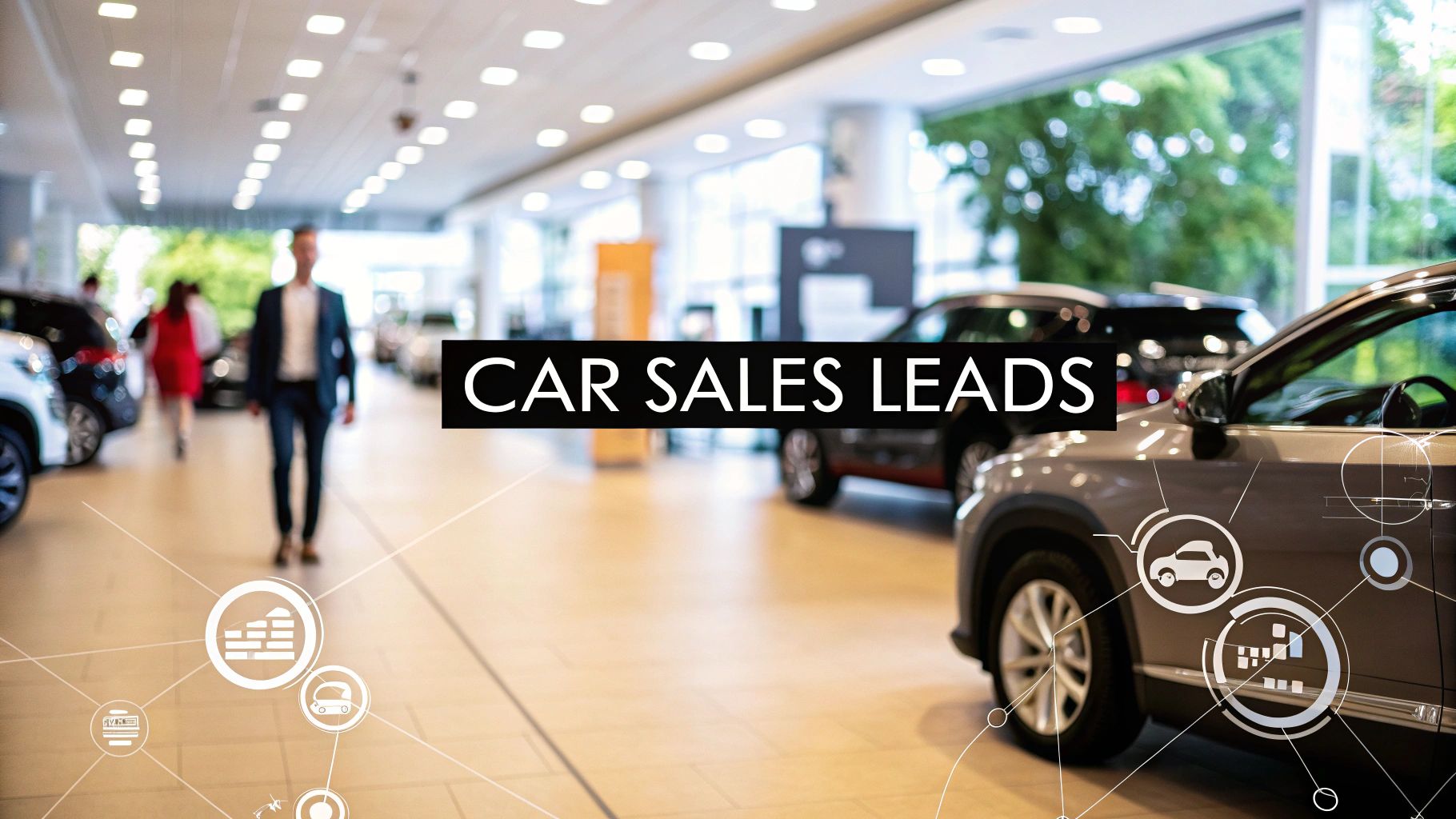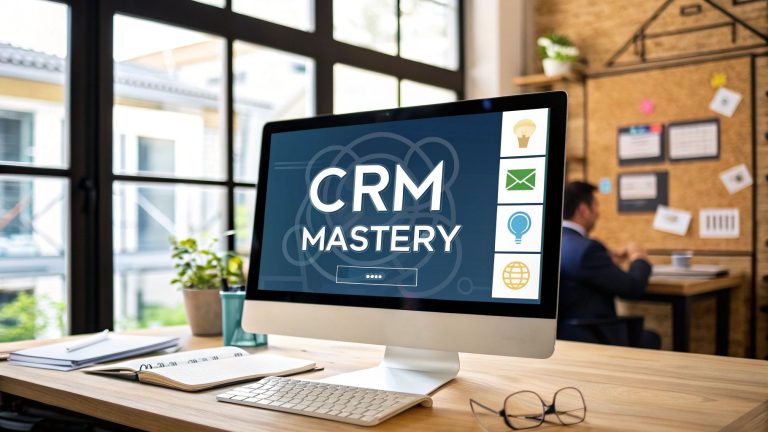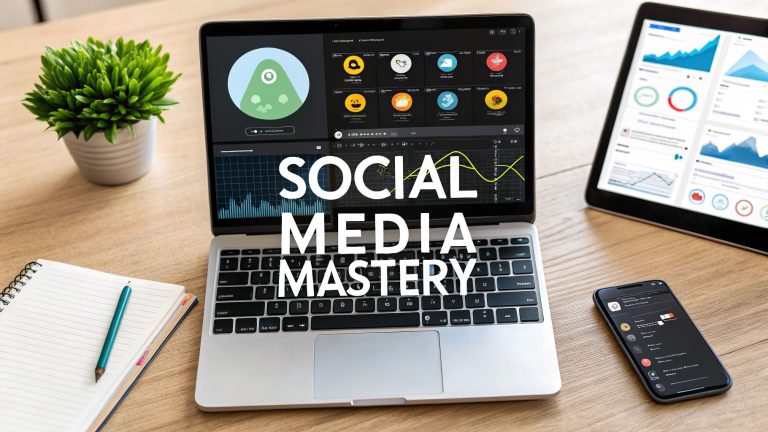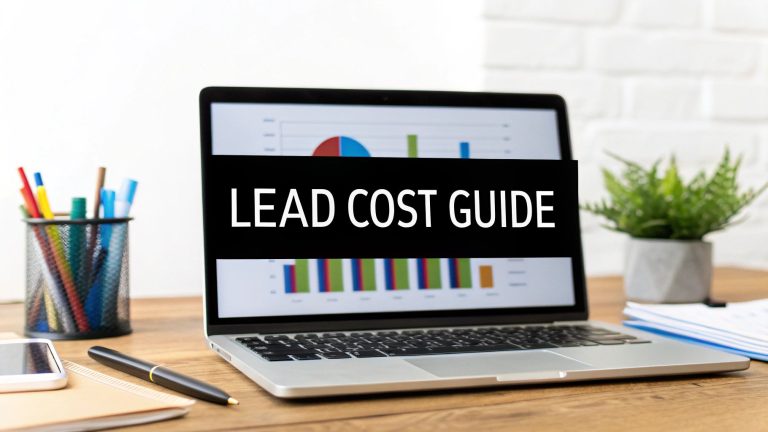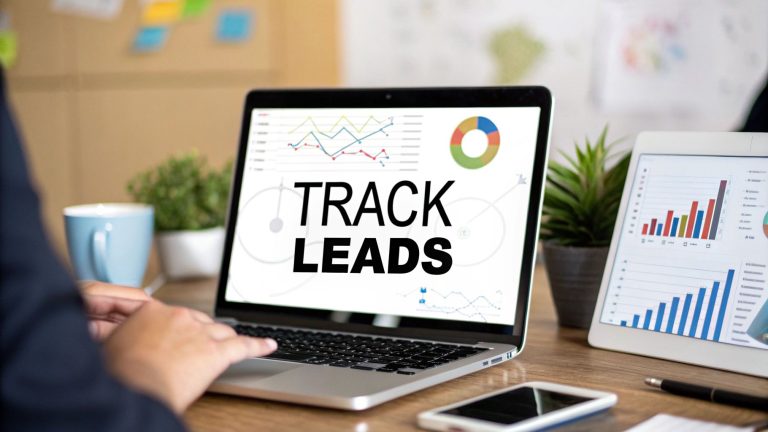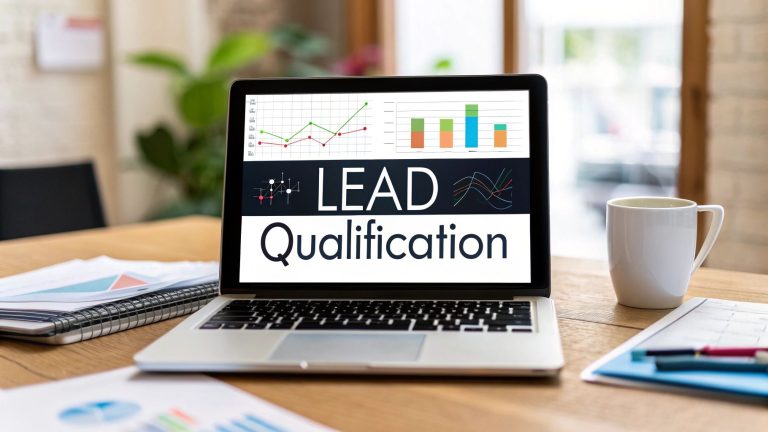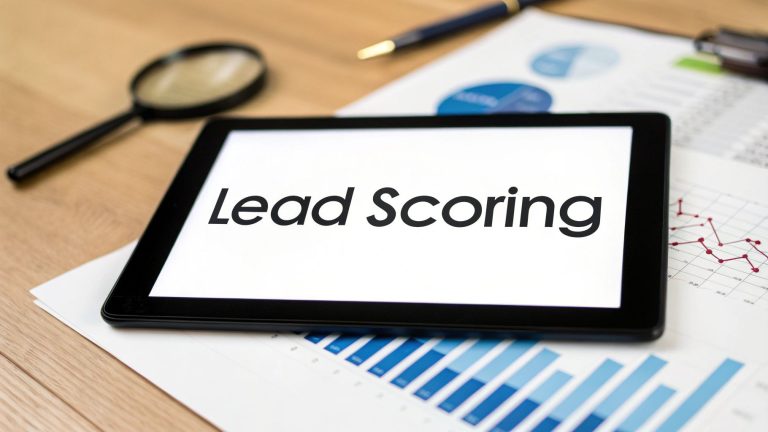how to generate car sales leads: dealership strategies
Let’s be honest: waiting for customers to wander into your showroom is a thing of the past. The real action happens online, long before anyone even thinks about taking a test drive.
If you're still relying on old-school newspaper ads and billboards, you're playing a losing game. Today's battle for car buyers is won on their phones and computers. Understanding how to generate a steady stream of car sales leads in this digital-first world isn't just a good idea—it's essential for keeping the doors open.
This isn't just theory. This is a practical blueprint for building a lead-generation machine that works 24/7, turning online interest into showroom appointments.
The Big Shift from Offline to Online
The modern car-buying journey starts with a Google search, not a trip to the dealership. The numbers don't lie: a successful dealership needs somewhere between 100 and 150 leads every single month just to hit its sales goals.
And where do those leads come from? Digital marketing. Strategies like SEO and social media pull in about 70% more leads than traditional offline tactics. With a staggering 83% of car buyers doing their homework online before they even think about visiting a lot, you simply have to be where they are.
The new playbook is simple: be the most helpful, visible, and responsive dealership in your area. It’s not about having the flashiest ads. It's about providing real value and being there with the right answer when a potential buyer is looking for it.
The Three Pillars of a Modern Lead Strategy
A rock-solid lead generation engine isn't built on just one thing. It stands on a few interconnected pillars that work together to attract, engage, and ultimately convert prospects into buyers.
-
A Dominant Online Presence: This starts with a website that's optimized for local search, so you show up when someone searches "used SUVs near me." It also means having active social media profiles that do more than just post pictures of cars—they build a community and earn trust.
-
Hyper-Targeted Advertising: Forget casting a wide net. Platforms like Google and Facebook let you run ads that reach people who are actively in the market for a car. Think new inventory alerts, special trade-in promotions, or service reminders, delivered directly to the right people at the right time.
-
Lightning-Fast Response: This one is a game-changer. You need automated systems in place to make sure every single online inquiry gets an immediate, personalized response. Waiting even a few minutes can be the difference between a hot lead and a missed opportunity.
Speaking of online presence, a huge part of any modern strategy is nailing your social media. Implementing the latest social media marketing best practices is non-negotiable for effectively reaching and engaging your target audience. Let's dive into how you can pull all these elements together to turn your lead flow from a trickle into a flood.
Key Lead Generation Channels At a Glance
To help you visualize where to focus your efforts, here's a quick breakdown of the primary digital channels for automotive lead generation. Each has its own strengths and requires a different approach to succeed.
| Channel | Primary Focus | Key Metrics to Track |
|---|---|---|
| SEO & Your Website | Attracting organic, high-intent local traffic | Organic traffic, keyword rankings, VDP views, form submissions |
| Paid Search (Google Ads) | Capturing immediate "in-market" buyers | Cost-per-click (CPC), cost-per-lead (CPL), conversion rate, ad position |
| Social Media Ads | Building brand awareness and targeting specific demographics | Reach, engagement rate, click-through rate (CTR), lead form completions |
| Social Media Organic | Fostering community, building trust, showcasing inventory | Follower growth, post engagement, website clicks, direct messages |
| Email Marketing | Nurturing past customers and unconverted leads | Open rate, click-through rate, unsubscribe rate, service appointments booked |
This table isn't just a list; it's a strategic map. A truly effective plan doesn't just use one of these channels—it integrates them into a seamless system where each one supports the others to drive consistent, high-quality leads.
Build a Digital Showroom That Attracts Buyers
Let's get one thing straight: your dealership’s website isn't just an online brochure anymore. It's your number one sales tool, your digital showroom, and it’s open 24/7. This is where the magic happens long before anyone steps on the lot. A mind-blowing 95% of vehicle buyers are digging through online sources for info, which means your website has to do the heavy lifting from the very beginning.
The core of a killer digital showroom is solid local SEO. The goal is to own the search results when someone in your area types in "car dealership near me" or "used trucks in [Your City]." This isn't about stuffing keywords everywhere. It’s about giving search engines and, more importantly, your customers the clear, helpful information they’re looking for.

This boils down to making every single page, especially your vehicle detail pages (VDPs), work hard to convert visitors. A VDP that just lists specs is a dead end. But a VDP that tells a story with stunning photos, a 360-degree virtual tour, and upfront pricing? That’s a lead-generating machine.
Optimize Your Vehicle Detail Pages
Your VDPs are the make-or-break moment where a casual browser decides to become a serious lead. Small tweaks here can have a massive impact on your bottom line. Don't just list the features; show them off.
- Go Big on Visuals: We’re talking at least 20-30 high-resolution images for every single vehicle. Even better, add a video walkaround that gives shoppers a real feel for the car, inside and out.
- Be Transparent: Put the price, VIN, mileage, and a complete vehicle history report right where people can see it. Hiding information just creates distrust and sends potential customers running to your competition.
- Write Compelling Calls-to-Action (CTAs): Ditch the generic "Contact Us." Get specific with value-driven CTAs that move the customer forward, like "Check Availability," "Schedule a Test Drive," or "Get Pre-Approved."
A well-optimized website doesn't just display inventory; it answers questions and builds trust before you ever speak to the customer. When a buyer feels informed and confident, they are far more likely to submit their information.
Create Content That Builds Authority
Your digital showroom should do more than just sell cars. It needs to position your dealership as the go-to local expert. This is where content marketing becomes your secret weapon, attracting buyers who are still in the early stages of their research.
Think about it: a detailed blog post comparing the Toyota Tundra to the Ford F-150 can pull in truck buyers who haven't even decided on a brand yet. This kind of content frames you as a helpful, unbiased expert—not just another salesperson pushing a vehicle. You can dive deeper into structuring these efforts in our guide on automotive lead generation strategies.
This approach delivers real value upfront, making your dealership the obvious choice when it’s finally time to pull the trigger. Your website transforms from a simple inventory list into the most trusted automotive resource in town. And that authority is what turns casual browsers into qualified leads who are actually ready to talk.
Using Paid Ads for Immediate and Predictable Leads
While your digital showroom is the bedrock of your long-term strategy, paid advertising is your high-octane fuel for hitting monthly sales targets. It’s the fastest way to put your best deals right in front of local buyers who are actively hunting for their next vehicle right now.
Forget about those broad, spray-and-pray campaigns of the past. The real magic in generating car sales leads with paid ads lies in hyper-targeting. This means going way beyond basic demographics and tapping into the powerful intent signals that platforms like Google and Facebook offer.
Advanced Targeting Strategies That Work
Success with paid ads isn't just about a big budget; it's about reaching the right person, with the right message, at the exact moment they're ready to act. Instead of just targeting by age or location, you can get incredibly granular to find the highest-quality prospects.
Here are a few tactics the pros use to stay ahead:
- VDP Retargeting: Someone who viewed a specific vehicle detail page (VDP) for a Ford F-150 on your site is a scorching hot lead. You can then serve them ads across Facebook and other sites showcasing that exact truck, maybe with a special offer, or even similar models you have in stock.
- Service Department Custom Audiences: Your service department's customer list is a goldmine. Upload this list to create a custom audience and run ads promoting exclusive trade-in offers or new model upgrades. These are people who already know and trust your dealership.
- "In-Market" Signals: Both Google and Facebook are smart enough to identify users who are actively researching vehicles online. Targeting these "in-market" audiences ensures your ad spend is focused only on people who are signaling they're ready to buy.
Crafting Ads That Convert
Your ad copy and visuals have one job: stop the scroll. A generic "Great Deals on New Cars!" ad is invisible. It'll get ignored every time. You need to speak directly to a buyer's biggest concerns and questions.
Think about it. An ad that says, "Worried About Financing? Get Pre-Approved in 60 Seconds," tackles a major pain point head-on. That’s powerful. Likewise, an ad promising a "Guaranteed Top-Dollar Offer on Your Trade-In" is far more compelling than a vague sales pitch.
For a complete walkthrough on this, our guide on how to create Facebook lead ads gives you the actionable steps to build campaigns that capture high-intent prospects directly inside the platform.
The most effective ads don't just sell a car; they offer a solution to a problem. Whether it's financing anxiety, trade-in uncertainty, or the fear of a lengthy process, addressing these issues in your ad builds instant trust and drives clicks.
For a deeper dive into the mechanics and frameworks, you can explore detailed resources on paid advertising strategies for customer acquisition. At the end of the day, a smart paid ad strategy isn't just about spending money—it's about making strategic investments that generate a predictable stream of appointments.
Automate Your Lead Response to Close More Deals
In the world of car sales, speed isn’t just about what's under the hood—it's the single most important factor in your lead response. You can spend a fortune on a slick digital presence and targeted ads, but if your follow-up is slow, you're bleeding profit.
That gap between a customer's inquiry and your first contact? That's where deals go to die. Every single second counts.
Think about it from the buyer's perspective. They’re excited, they’ve just found a car they love, and they hit "submit." That excitement fades fast. If they're left waiting hours for a response, they're not just sitting around—they're clicking on the next dealership in the search results. This is where you can instantly get a leg up on the competition.
The Make-or-Break Golden Hour
There's a reason we call the first hour after an inquiry the "golden hour." It’s your make-or-break moment. The data is clear: leads contacted within this first hour are a staggering seven times more likely to convert than those reached just an hour later.
And yet, the average dealership takes around 9.2 hours to respond. You can dig into more of these crucial automotive marketing trends and see how to capitalize on them. This delay isn't just a minor slip-up; it's a direct hit to your bottom line.
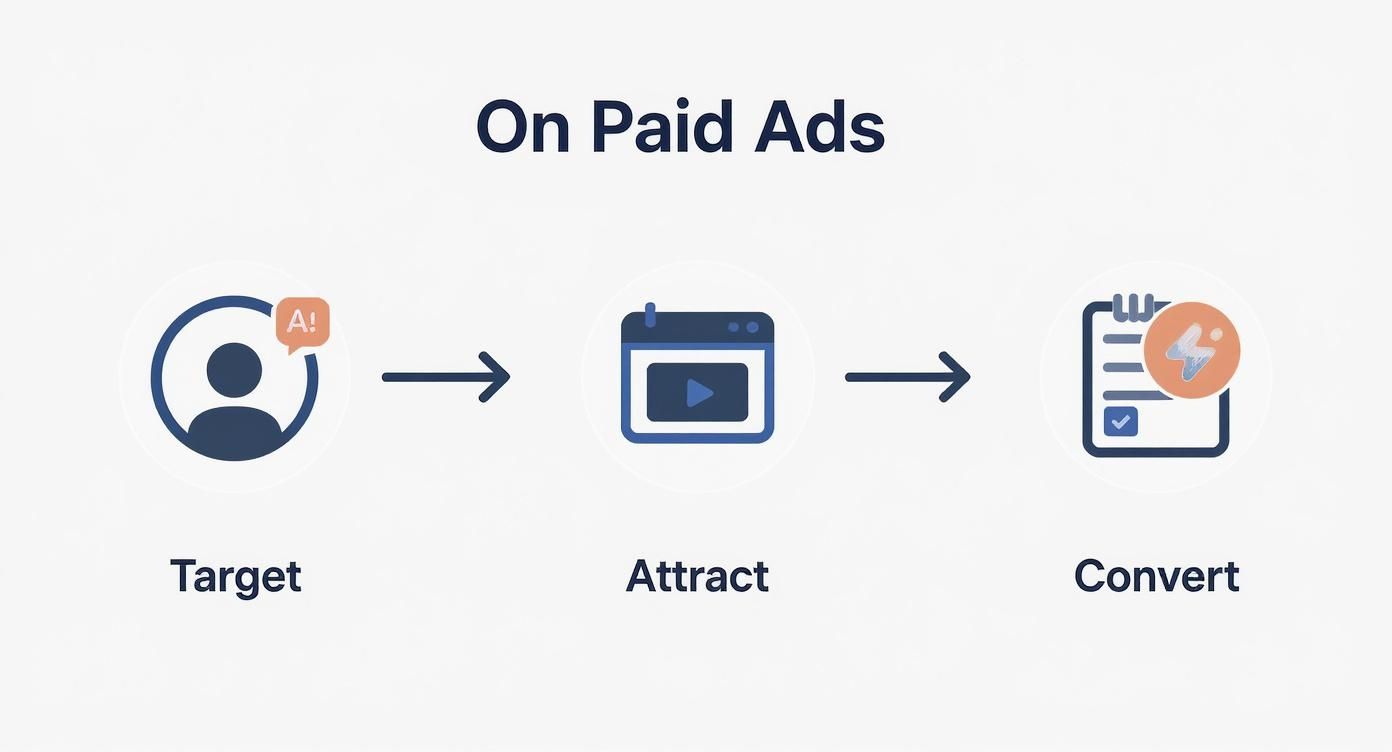
This whole process hinges on that final step: conversion. By automating your initial outreach, you guarantee the 'Convert' stage kicks off immediately, pushing prospects toward an appointment before they even think about looking elsewhere.
The goal isn't to replace your sales team with robots. It's about empowering them. Automation ensures every single lead gets an immediate, personalized touch, freeing up your team to focus on what they do best: talking to warm, engaged prospects who are ready to buy.
Building Your Instant Engagement Engine
Setting up automation isn't nearly as complicated as it sounds. We're talking about simple, powerful workflows that engage a customer the second they show interest. It’s not just about being fast; it’s about providing instant value and making that customer feel heard.
Here’s how you can get started right away:
- Instant SMS and Email Confirmation: The moment a lead form is submitted, they should get an automated text and email. Something simple like, "Hi [Name], thanks for your interest in the [Vehicle Model]! A member of our team will call you shortly. In the meantime, you can schedule your test drive here: [Link]."
- 24/7 Appointment Scheduling: Give them the power to book on their own time. By integrating a self-service scheduling tool, a motivated buyer can book a test drive at 10 PM without ever speaking to a person. That lead goes right onto your calendar.
- Instant Trade-In Estimators: Offer an automated tool that provides a no-obligation trade-in value on the spot. This not only captures valuable lead info but gives the prospect a tangible reason to keep the conversation going with your dealership.
This immediate, two-pronged approach does a couple of things perfectly. First, it confirms you got their request, which builds instant trust. Second, and more importantly, it keeps them on your website and engaged with your brand while their buying intent is at its absolute peak. You're not just responding to an inquiry; you're turning a cold click into a warm, active conversation.
A quick look at the difference between the old way and the new way makes it obvious why automation is no longer optional.
Manual vs. Automated Lead Follow-Up
| Metric | Manual Follow-Up | Automated Follow-Up (e.g., CRM) |
|---|---|---|
| Response Time | Hours (or even days) | Seconds to minutes |
| Consistency | Varies by salesperson, time of day | 100% consistent, 24/7 |
| Personalization | Generic first touch | Can be personalized with lead data |
| Lead "Leakage" | High (leads fall through the cracks) | Minimal (every lead is logged/contacted) |
| Efficiency | Sales team bogged down by cold outreach | Sales team focuses on warm, engaged leads |
The table really speaks for itself. Relying on manual follow-up means you're always playing catch-up, but an automated system ensures you're first out of the gate, every single time.
Design a Follow-Up System That Builds Relationships
Getting a lead is the starting whistle, not the finish line. The real work of closing a deal starts the moment that lead hits your system, and it all comes down to a smart, persistent follow-up that feels human, not robotic. Your success hinges on a well-designed sequence that keeps your dealership top-of-mind without ever feeling annoying.
The trick is to move beyond the generic "just checking in" approach. Every single touchpoint—whether it's a text, email, or call—has to provide real value. When you do that, follow-up stops being a sales chore and becomes a genuine opportunity to build a relationship.

This proactive approach is everything, especially when you learn that a shocking 45% of auto leads never get any follow-up within the first hour. That golden window is where the magic happens, and missing it is a costly mistake. Think about it: about one-third of customers would rather talk to a real person than fill out a form. Speed matters.
Crafting a Multi-Touch Follow-Up Cadence
A winning follow-up strategy is a mix of automated efficiency and personal connection. You want to create a cadence that feels helpful and attentive, not pushy. And those first few days? They are absolutely crucial for setting the right tone.
Here’s a sample framework you can steal and adapt for your dealership:
- First 5 Minutes: An automated SMS and email go out instantly. This message confirms their inquiry about a specific vehicle and includes a direct link to book a test drive. Simple and effective.
- Day 1 (Within 1 Hour): A personal phone call from a salesperson. This is your first real human touchpoint, designed to answer any quick questions and start building rapport.
- Day 2: Send a personalized video message. Have the salesperson shoot a quick walkaround video of the exact car the prospect asked about, mentioning them by name. It's a game-changer.
- Day 4: A value-add email. Don't ask for anything. Instead, send a link to a helpful resource, like a financing guide or a side-by-side comparison of similar models in your inventory.
- Day 7: Another personal call. Just a brief check-in to see if they’ve had a chance to look over the info and if anything has changed on their end.
Your follow-up system should be designed to serve the customer, not just chase a sale. By consistently offering value—a personalized video, a helpful guide, a quick answer—you build the trust needed to earn their business when they are finally ready to buy.
This process shows you're committed to helping them, making your dealership the obvious choice. For a deeper dive into the timing and messaging, check out our comprehensive guide on https://leadsavvy.pro/post/lead-follow-up/. By mastering this sequence, you ensure every lead gets the attention it deserves, turning inquiries into appointments and appointments into sales.
Know Your Numbers: How to Measure and Optimize Your Lead Funnel
You can't fix what you don't measure. Pouring money into ads or content without knowing the real-world results is like driving with a blindfold on.
If you want to build a sustainable engine for generating car sales leads, you have to track, analyze, and constantly tweak your approach. This isn’t about chasing vanity metrics; it’s about making smart decisions that directly grow your bottom line.
Think of your CRM and tools like Google Analytics as your command center. They give you the raw data you need to see what’s actually working and what’s just wasting your budget. The goal here is to stop guessing and start diagnosing your sales funnel with surgical precision.
Pinpoint the Metrics That Actually Matter
Don't get lost in a sea of data. Honestly, a handful of key performance indicators (KPIs) will tell you 90% of what you need to know about the health of your lead generation.
Focus on tracking these core numbers:
- Cost Per Lead (CPL): This tells you exactly how much you're spending to get a single lead from each channel, whether that's Google Ads, Facebook, or your SEO efforts.
- Lead-to-Appointment Ratio: Out of all the leads you generate, what percentage actually book an appointment? A low number here is a huge red flag, usually pointing to a problem in your follow-up process.
- Appointment-to-Sale Ratio: This one shines a spotlight on your sales team's effectiveness. It shows how many of those appointments turn into actual vehicle sales.
- Channel-Specific Close Rate: This is where the magic really happens. By tracking which lead sources (e.g., organic search, paid ads, social media) have the highest close rates, you know exactly where to double down.
I've seen dealerships discover that their organic SEO leads, while maybe fewer in number, close at twice the rate of their paid leads. That single insight lets you reallocate your marketing budget intelligently—investing more in content and SEO to attract those higher-quality prospects who are ready to buy.
This data-first approach takes the emotion and guesswork out of your strategy.
Instead of running campaigns based on what you think is working, you start making decisions based on what the numbers prove. By keeping a close eye on these metrics, you can spot the leaks in your funnel, optimize your ad spend, and systematically make your entire marketing operation more profitable.
Frequently Asked Questions
How Many Leads Does a Car Salesman Need a Month?
This is the million-dollar question, isn't it? While many managers throw around the number 100 to 150 quality leads a month as a benchmark, the real answer is… it depends.
Honestly, the raw number is less important than the quality of the lead and how fast you follow up. I'd rather have 50 genuinely interested buyers who I can connect with immediately than 150 lukewarm leads that are just kicking tires. The focus should always be on engagement, not just hitting a volume target.
What Is the Most Effective Channel for Car Sales Leads?
There’s no single silver bullet here. The most successful dealerships I've seen don't put all their eggs in one basket. They run a multi-channel playbook.
Think of it this way: SEO is your net for catching high-intent buyers who are actively searching for "used SUV near me." At the same time, targeted social media ads are your megaphone, building awareness and reaching people who might not even know they're in the market yet. The magic happens when you integrate them into one seamless strategy.
A quick note on third-party leads: they can be a good way to supplement your pipeline, but remember, you're often getting leads that have also been sent to five other dealerships down the street. Focusing on generating your own exclusive leads through your website and targeted ads will almost always give you a higher—and more sustainable—return.
Stop wasting time on manual downloads and start converting more leads today. LeadSavvy Pro automates your Facebook lead capture, sending new prospects directly to your CRM or a Google Sheet in real-time. Sign up for a free plan and see how it works.

